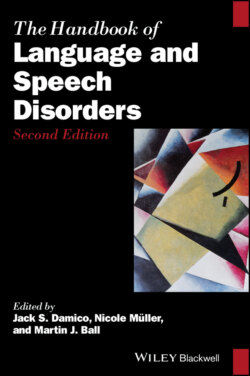Читать книгу The Handbook of Language and Speech Disorders - Группа авторов - Страница 59
4.1 Introduction
ОглавлениеIntelligibility is a critical concern in speech‐language pathology, impacting a wide range of individuals across populations, with ages ranging across the lifespan. For example, intelligibility is an important developmental concern for children who are acquiring speech, including those with and without risk factors for speech impairment (Hustad, Mahr, & Rathouz, 2020). Speech intelligibility impairments in children can stem from speech sound disorders, childhood apraxia, conditions associated with neuromotor involvement or disease (cerebral palsy, childhood brain injury or stroke), genetic etiologies (Down syndrome, cleft palate), or sensory involvement (hearing impairment). In adults, intelligibility remains an important concern for individuals with many of the aforementioned childhood onset etiologies as well as for individuals with adult onset etiologies. Adult onset etiologies include those that have a degenerative course affecting speech motor control (e.g., amyotrophic lateral sclerosis, Parkinson’s disease, Huntington’s disease), those with a recovering course (e.g., stroke, traumatic brain injury during the post‐onset recovery window), and those with a persistent stable course (stroke, traumatic brain injury, cerebral palsy, and other chronic conditions). The field of motor speech disorders has had a particularly notable and longstanding interest in speech intelligibility, in part because reductions in intelligibility are very frequently associated with dysarthria (Darley, Aronson, & Brown, 1969). Improving intelligibility has long been considered a key goal of treatment for this population (Ansel & Kent, 1992).
Clinically, intelligibility measures provide an important metric that can be used for treatment decision‐making. Intelligibility measures are often used as a basis of comparison for documenting and monitoring change in speech performance (Yorkston, Beukelman, Strand, & Bell, 1999), as an index of severity of the speech disorder (Weismer & Martin, 1992), and as an indicator of functional ability (or disability) relative to “normal” performance (Yorkston et al., 1999). Critical clinical concerns such as justifying treatment for third‐party payers, and deciding whether or not to discontinue intervention, sometimes may be made on the basis of intelligibility measures.
